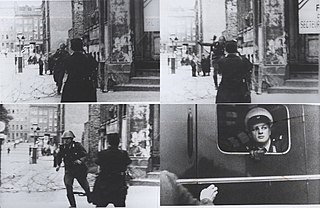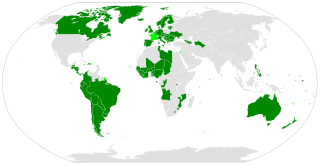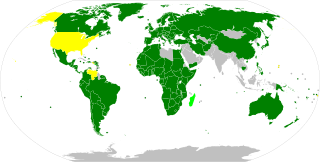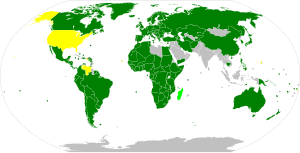Nationality is the status of belonging to a particular nation, defined as a group of people organized in one country, under one legal jurisdiction, or as a group of people who are united on the basis of culture.
The Office of the United Nations High Commissioner for Refugees (UNHCR) is a United Nations agency mandated to aid and protect refugees, forcibly displaced communities, and stateless people, and to assist in their voluntary repatriation, local integration or resettlement to a third country. It is headquartered in Geneva, Switzerland, with over 18,879 staff working in 138 countries as of 2020.

A refugee, conventionally speaking, is a person who has lost the protection of their country of origin and who cannot or is unwilling to return there due to well-founded fear of persecution. Such a person may be called an asylum seeker until granted refugee status by the contracting state or the United Nations High Commissioner for Refugees (UNHCR) if they formally make a claim for asylum.
An asylum seeker is a person who leaves their country of residence, enters another country and applies for asylum in that other country. An asylum seeker is an immigrant who is making a claim to have been forcibly displaced and might have fled their home country because of war or other factors harming them or their family. If their case is accepted, they become considered a refugee. The terms asylum seeker, refugee and illegal immigrant are often confused.
In international law, a stateless person is someone who is "not considered as a national by any state under the operation of its law". Some stateless people are also refugees. However, not all refugees are stateless, and many people who are stateless have never crossed an international border. At the end of 2022, the United Nations High Commissioner for Refugees estimated 4.4 million people worldwide as either stateless or of undetermined nationality, 90,800 (+2%) more than at the end of 2021.
Refugee law is the branch of international law which deals with the rights and duties states have vis-a-vis refugees. There are differences of opinion among international law scholars as to the relationship between refugee law and international human rights law or humanitarian law.

The Convention on the Elimination of all Forms of Discrimination Against Women (CEDAW) is an international treaty adopted in 1979 by the United Nations General Assembly. Described as an international bill of rights for women, it was instituted on 3 September 1981 and has been ratified by 189 states. Over fifty countries that have ratified the convention have done so subject to certain declarations, reservations, and objections, including 38 countries who rejected the enforcement article 29, which addresses means of settlement for disputes concerning the interpretation or application of the convention. Australia's declaration noted the limitations on central government power resulting from its federal constitutional system. The United States and Palau have signed, but not ratified the treaty. The Holy See, Iran, Somalia, Sudan, and Tonga are not signatories to CEDAW.
The right of asylum is an ancient juridical concept, under which people persecuted by their own rulers might be protected by another sovereign authority, like a second country or another entity which in medieval times could offer sanctuary. This right was recognized by the Ancient Egyptians, the Greeks, and the Hebrews, from whom it was adopted into Western tradition. René Descartes fled to the Netherlands, Voltaire to England, and Thomas Hobbes to France, because each state offered protection to persecuted foreigners.
Non-refoulement is a fundamental principle of international law that forbids a country receiving asylum seekers from returning them to a country in which they would be in probable danger of persecution based on "race, religion, nationality, membership of a particular social group or political opinion". Unlike political asylum, which applies to those who can prove a well-grounded fear of persecution based on certain category of persons, non-refoulement refers to the generic repatriation of people, including refugees into war zones and other disaster locales. It is a principle of customary international law, as it applies even to states that are not parties to the 1951 Convention Relating to the Status of Refugees or its 1967 Protocol.
World Refugee Day is an international day organised every year on 20 June by the United Nations. It is designed to celebrate and honour refugees from around the world. The day was first established on 20 June 2001, in recognition of the 50th anniversary of the 1951 Convention Relating to the Status of Refugees.

The Convention on the Reduction of Statelessness is a 1961 United Nations multilateral treaty whereby sovereign states agree to reduce the incidence of statelessness. The Convention was originally intended as a Protocol to the Convention Relating to the Status of Refugees, while the 1954 Convention Relating to the Status of Stateless Persons was adopted to cover stateless persons who are not refugees and therefore not within the scope of the Convention Relating to the Status of Refugees.

The Convention Relating to the Status of Stateless Persons is a 1954 United Nations multilateral treaty that aims to protect stateless individuals.

The Protocol Relating to the Status of Refugees is a key treaty in international refugee law. It entered into force on 4 October 1967, and 146 countries are parties.
The Russian Federation's Law on Refugees defines who is a refugee for purposes of obtaining asylum in the country. The Law defines a refugee as a "person who is outside their country of nationality or habitual residence; has a well-founded fear of persecution because of their race, religion, nationality, membership in a particular social group or political opinion; and is unable or unwilling to avail themself of the protection of that country, or to return there, for fear of persecution". Upon receiving an asylum seeker's application, the Russian Migration Service determines whether the asylum seeker meets the legislative definition of a "refugee" and should be granted asylum.
Subsidiary protection is international protection for persons seeking asylum who do not qualify as refugees. In European law, Directive 2004/83/EC defines the minimum standards for qualifying for subsidiary protection status. The Directive was later added to with Directive 2011/95/EU, which states that uniform, European states for persons eligible for subsidiary protection and the content of the protection granted.
The Organisation of African Unity (OAU) Convention Governing the Specific Aspects of Refugee Problems in Africa, also called the OAU Refugee Convention, or the 1969 Refugee Convention, is regional legal instrument governing refugee protection in Africa. It comprises 15 articles and was enacted in Addis Ababa on September 10, 1969, and entered into forced on June 20, 1974. It builds on the 1951 Refugee Convention and the 1967 Protocol and it has influenced the 1984 Cartagena Declaration and the 2009 Kampala Convention. The 1969 Refugee Convention's historical context is the era of decolonization, Apartheid, as well as internal political and military uprisings.
The Cartagena Declaration on Refugees, or just Cartagena Declaration, is a non-binding regional, i.e. Latin-American, instrument for the protection of refugees and was adopted in 1984 by delegates from 10 Latin-American countries: Belize, Colombia, Costa Rica, El Salvador, Guatemala, Honduras, Mexico, Nicaragua, Panama and Venezuela. The Declaration has since been incorporated into the national laws and state practices of 14 countries.
Paul Weis was an Austrian lawyer and survivor of the persecution by the Nazis. He is dubbed to be the "founding father of the protection".
Immigration detention of refugee and asylum seeking children in Thailand violates the rights of children under international law. The undocumented migrant children are detained for indefinite and prolonged periods without proper access to legal support. Thailand is key transit route, host and final destination for refugees seeking asylum in southeast Asia and Australia. During the Universal Periodic Review (UPR) session in May 2016, various human rights issues including detention of refugee and asylum seeking children were reported. Currently, there are no effective alternatives to immigration detention and all sectors of population including children are subject to detention.





